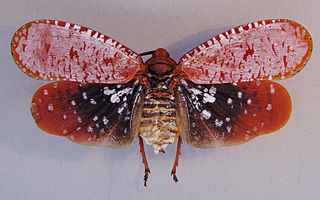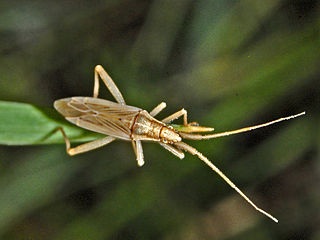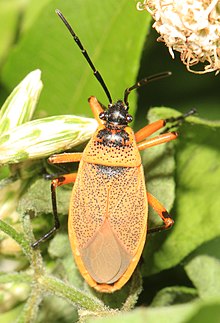
The family Fulgoridae is a large group of hemipteran insects, especially abundant and diverse in the tropics, containing over 125 genera worldwide. They are mostly of moderate to large size, many with a superficial resemblance to Lepidoptera due to their brilliant and varied coloration. Various genera and species are sometimes referred to as lanternflies or lanthorn flies.

Pentatominae is a subfamily of Pentatomidae, a family of shield bugs. This subfamily is the largest one within the Pentatomidae, having 4937 species classified in 938 genera. Species in this subfamily are phytophages and several of them are considered agricultural pests. Some invasive pentatomines such as Halyomorpha halys and Bagrada hilaris have been considered household pests. Higher systematics of the group have been revised by Rider et al.

Eurybrachidae is a small family of planthoppers with species occurring in parts of Asia, Australia and Africa. They are remarkable for the sophistication of their automimicry.

Alydidae, commonly known as broad-headed bugs, is a family of true bugs very similar to the closely related Coreidae. There are at least 60 genera and 300 species altogether. Distributed in the temperate and warmer regions of the Earth, most are tropical and subtropical animals; for example Europe has a mere 10 species, and only 2 of these occur outside the Mediterranean region.

Dindymus is Old World genus of true bugs in the family Pyrrhocoridae. Records of occurrence include Africa, but most are in SE Asia and Australia.

The subfamily Aphaeninae is a group of hemipteran insects, especially abundant and diverse in the tropics, in the family Fulgoridae, or "lanternflies".

The Harpactorinae are a large subfamily of the Reduviidae. About 300 genera and 2,000 species worldwide have been described. Some of the species of the genera Zelus, Pselliopus, Sinea, and Apiomerus are of interest as biological pest control agents.

Cercopidae are the largest family of Cercopoidea, a xylem-feeding insect group, commonly called froghoppers. They belong to the hemipteran suborder Auchenorrhyncha. A 2023 phylogenetic study of the family suggested the elevation of subfamily Ischnorhininae to full family status as Ischnorhinidae, leaving a monophyletic Cercopinae.

Adelphocoris is a genus of capsid bugs in the tribe Mirini. It is part of a genus group that now includes Creontiades, Megacoelum and Pseudomegacoelum.

Issidae is a family of planthoppers described by Spinola in 1839, belonging to the order Hemiptera, suborder Auchenorrhyncha superfamily Fulgoroidea.

Nogodinidae is a family of planthoppers. They have membranous wings with delicate venation and can be confused with members of other Fulgoroid families such as the Issidae and Tropiduchidae. Some authors treat it as a subfamily of the Issidae.

Stenodema is a genus of Palaearctic, Oriental and Nearctic plant bugs in the family Miridae and the tribe Stenodemini.

Dysdercus is a widespread genus of true bugs in the family Pyrrhocoridae; a number of species attacking cotton bolls may be called "cotton stainers".

Irbisia is a genus of plant bugs in the family Miridae. There are more than 20 described species in Irbisia. These black insects are 5–8 mm in length. They are also called black grass bugs as they are common in spring grasses.

Tropiduchinae is a subfamily of tropiduchid planthoppers in the family Tropiduchidae.

Cosmoscarta is a genus of froghoppers found in the Indo-Malayan region. Many of the species are boldly marked in black and red or yellow. A few species are of economic importance as they can cause injury to plants under cultivation.
Tropiduchus is a genus of planthoppers, recorded from Africa and Malesia.

The Nogodininae are a sub-family of tropical planthoppers erected by Leopold Melichar in 1898. The recorded distribution is: South America, Africa and the Middle East, South and SE Asia through to Australia.

















